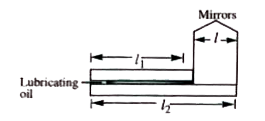An optical engineering question firm needs to ensure the separation between two mirrors is unaffected by temperature changes. The mirrors are attached to the ends of two bars of different materials that are welded together at one end as shown in figure. The surfaces of the bars are lubricated. If the coefficient of linear expansions of the two rods ( of initial length L1andL2 ) are α1andα2 respectively and L is the distance between the two mirrors initially, then

L1=Lα1α2−α1
L1=Lα2α2−α1
L2=Lα1α2−α1
L2=Lα2α2−α1
The correct Answer is:B
Topper's Solved these Questions
- THERMAL PROPERTIES OF MATTERBOOK - AAKASH SERIESCHAPTER - THERMAL PROPERTIES OF MATTEREXERCISE - ADDITIONAL PRACTICE EXERCISE (LEVEL - II) PRACTICE SHEET (ADVANCED) Straight Objective Type Questions (Expansion of Liquids :)
6 Videos
- THERMAL PROPERTIES OF MATTERBOOK - AAKASH SERIESCHAPTER - THERMAL PROPERTIES OF MATTEREXERCISE - ADDITIONAL PRACTICE EXERCISE (LEVEL - II) PRACTICE SHEET (ADVANCED) Straight Objective Type Questions (Expansion of Gases & KTG :)
9 Videos
- THERMAL PROPERTIES OF MATTERBOOK - AAKASH SERIESCHAPTER - THERMAL PROPERTIES OF MATTEREXERCISE - ADDITIONAL PRACTICE EXERCISE (LEVEL - II) PRACTICE SHEET (ADVANCED) Straight Objective Type Questions (Thermometry:)
8 Videos
- SYSTEM OF PARTICLES AND ROTATIONAL MOTIONBOOK - AAKASH SERIESCHAPTER - SYSTEM OF PARTICLES AND ROTATIONAL MOTIONEXERCISE - PRACTICE EXERCISE
99 Videos
- THERMODYNAMICSBOOK - AAKASH SERIESCHAPTER - THERMODYNAMICSEXERCISE - EXERCISE - 3
33 Videos
Similar Questions
A thin rod, length L0 at 0∘C and coefficient of linear expansion α has its two ends mintained at temperatures θ1 and θ2 respectively Find its new length .
View SolutionA composite bar of length L=L1+L2 is made from a bar of material 1 and length L1 attached to a bar of material 2 and length L2. Find the effective linear expansion α of this bar.The coefficinets of linear expansion of the material of the rods are α1 and α2 respectively.
View Solution
Knowledge Check
Two rods of lengths L1 and L2 are welded together to make a composite rod of length (L1+L2). If the coefficient of linear expansion of the materials of the rod are α1 and α2 respectively. The effective coefficient of linear expansion of the composite rod is
AL1α1−L2α2L1+L2BL1α1+L2α2L1+L2C√α1α2Dα1+α22A thin rod, length L0 at 0∘C and coefficient of linear expansion α has its two ends mintained at temperatures θ1 and θ2 respectively Find its new length .
AL0[1+α(θ1+θ2)]BL0(1+α(θ1+θ22))CL0(1+αθ1)DL0(1+α(θ1+θ22))Two rods of length l1 and l2 are made of material whose coefficient of linear expansion are α1 and α2 , respectively. The difference between their lengths will be independent of temperatiure if l1/l2 is to
Aα1α2Bα2α1C(α1α2)1/2D(α2α1)1/2
Two rods of length l1 and l2 are made of material whose coefficient of linear expansion are α1 and α2 , respectively. The difference between their lengths will be independent of temperatiure if l1/l2 is to
View SolutionTwo rods having length l1 and l2, made of materials with the linear coefficient of expansion α1 and α2 were welded together. The equivalent coefficients of linear expansion for the obtained rod:-

View SolutionIf L1 and L2 are the lengths of two rods of coefficients of linear expansion α1 and α2 respectively the condition for the difference in lengths to be constant at all temperatures is
View SolutionTwo rods having length l1 and l2, made of materials with the linear expansion coefficient α1 and α2, were soldered together. The equivalent coefficient of linear expansion for the obtained rod is
View SolutionThe coefficient of linear expansion of an in homogeneous rod change linearly from α1 to α2 from one end to the other end of the rod. The effective coefficient of linear expansion of rod is
View Solution
